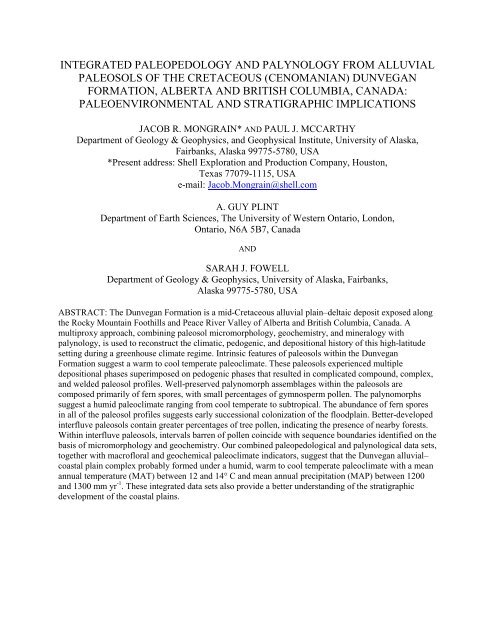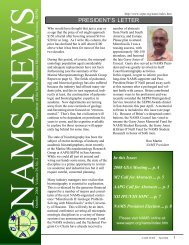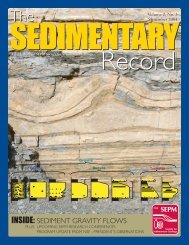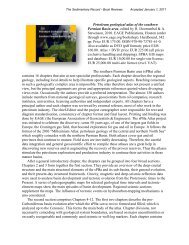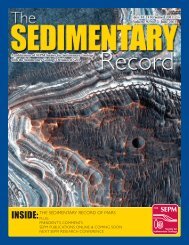PDF of contents and abstracts - SEPM
PDF of contents and abstracts - SEPM
PDF of contents and abstracts - SEPM
You also want an ePaper? Increase the reach of your titles
YUMPU automatically turns print PDFs into web optimized ePapers that Google loves.
INTEGRATED PALEOPEDOLOGY AND PALYNOLOGY FROM ALLUVIAL<br />
PALEOSOLS OF THE CRETACEOUS (CENOMANIAN) DUNVEGAN<br />
FORMATION, ALBERTA AND BRITISH COLUMBIA, CANADA:<br />
PALEOENVIRONMENTAL AND STRATIGRAPHIC IMPLICATIONS<br />
JACOB R. MONGRAIN* AND PAUL J. MCCARTHY<br />
Department <strong>of</strong> Geology & Geophysics, <strong>and</strong> Geophysical Institute, University <strong>of</strong> Alaska,<br />
Fairbanks, Alaska 99775-5780, USA<br />
*Present address: Shell Exploration <strong>and</strong> Production Company, Houston,<br />
Texas 77079-1115, USA<br />
e-mail: Jacob.Mongrain@shell.com<br />
A. GUY PLINT<br />
Department <strong>of</strong> Earth Sciences, The University <strong>of</strong> Western Ontario, London,<br />
Ontario, N6A 5B7, Canada<br />
AND<br />
SARAH J. FOWELL<br />
Department <strong>of</strong> Geology & Geophysics, University <strong>of</strong> Alaska, Fairbanks,<br />
Alaska 99775-5780, USA<br />
ABSTRACT: The Dunvegan Formation is a mid-Cretaceous alluvial plain–deltaic deposit exposed along<br />
the Rocky Mountain Foothills <strong>and</strong> Peace River Valley <strong>of</strong> Alberta <strong>and</strong> British Columbia, Canada. A<br />
multiproxy approach, combining paleosol micromorphology, geochemistry, <strong>and</strong> mineralogy with<br />
palynology, is used to reconstruct the climatic, pedogenic, <strong>and</strong> depositional history <strong>of</strong> this high-latitude<br />
setting during a greenhouse climate regime. Intrinsic features <strong>of</strong> paleosols within the Dunvegan<br />
Formation suggest a warm to cool temperate paleoclimate. These paleosols experienced multiple<br />
depositional phases superimposed on pedogenic phases that resulted in complicated compound, complex,<br />
<strong>and</strong> welded paleosol pr<strong>of</strong>iles. Well-preserved palynomorph assemblages within the paleosols are<br />
composed primarily <strong>of</strong> fern spores, with small percentages <strong>of</strong> gymnosperm pollen. The palynomorphs<br />
suggest a humid paleoclimate ranging from cool temperate to subtropical. The abundance <strong>of</strong> fern spores<br />
in all <strong>of</strong> the paleosol pr<strong>of</strong>iles suggests early successional colonization <strong>of</strong> the floodplain. Better-developed<br />
interfluve paleosols contain greater percentages <strong>of</strong> tree pollen, indicating the presence <strong>of</strong> nearby forests.<br />
Within interfluve paleosols, intervals barren <strong>of</strong> pollen coincide with sequence boundaries identified on the<br />
basis <strong>of</strong> micromorphology <strong>and</strong> geochemistry. Our combined paleopedological <strong>and</strong> palynological data sets,<br />
together with macr<strong>of</strong>loral <strong>and</strong> geochemical paleoclimate indicators, suggest that the Dunvegan alluvial–<br />
coastal plain complex probably formed under a humid, warm to cool temperate paleoclimate with a mean<br />
annual temperature (MAT) between 12 <strong>and</strong> 14° C <strong>and</strong> mean annual precipitation (MAP) between 1200<br />
<strong>and</strong> 1300 mm yr -1 . These integrated data sets also provide a better underst<strong>and</strong>ing <strong>of</strong> the stratigraphic<br />
development <strong>of</strong> the coastal plains.


